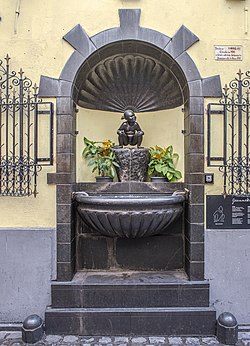Jeanneke Pis
| Jeanneke Pis | |
|---|---|
 | |
 Location within Brussels | |
| Artist | Denis-Adrien Debouvrie |
| Year |
|
| Type | Bronze |
| Dimensions | 50 cm (20 in) |
| Location | City of Brussels, Brussels-Capital Region, Belgium |
| 50°50′54.5″N 4°21′14.5″E / 50.848472°N 4.354028°E | |
| Website | Official website |
Jeanneke Pis (pronounced [ˌʑɑnəkə ˈpɪs]; Dutch for 'Little Pissing Joan') is a modern fountain sculpture in central Brussels, Belgium. It was commissioned by Denis-Adrien Debouvrie in 1985 and erected in 1987 as a counterpoint to the city's famous Manneken Pis.[1][2][3] The 50-centimetre (20 in) bronze statue depicts a naked little girl with short pigtails, squatting and urinating on a blue-grey limestone base.
Jeanneke Pis is located north of the Grand-Place/Grote Markt (Brussels' main square), on the eastern side of the Impasse de la Fidélité/Getrouwheidsgang, a narrow cul-de-sac some 30 metres (100 ft) long leading northwards off the restaurant-packed Rue des Bouchers/Beenhouwersstraat. The sculpture is now protected from vandalism by iron bars.

History
Conception
Denis-Adrien Debouvrie got the idea of Jeanneke Pis in 1985 as a way to restore then-waning interest in a small alley in Brussels called the Impasse de la Fidélité/Getrouwheidsgang ("Fidelity Alley"), where he owned many restaurants. He also saw it as a metaphorical way of "restoring equality between men and women" by creating a feminine counterpart to the city's illustrious Manneken Pis sculpture.[4] The idea for the statue is said to have come to him while he was having breakfast one day, and he sketched it out on the tablecloth. Upon completing the sketch, Debouvrie is purported to have said, "Now we have gender equality."[2] The appearance of the girl is also said to have been inspired by Debouvrie's younger sister Jenny's appearance as a child.[4]
Inauguration
Many inauguration ceremonies were held for the statue's reveal in June 1987, two in particular being of note. At the first ceremony, the guests of honour were the mayor of the City of Brussels and The Order of the Friends of Manneken Pis, the non-profit organisation that manages the costumes that Manneken Pis wears. The second ceremony saw the appearance of the Italian politician and former porn star Ilona Staller, also known as "Cicciolina", as a way of symbolising the naturalism that the statue represents.[4]
Eventually, the statue was put behind iron bars to protect it from vandals, as people had been touching the area surrounding the statue and ruining it. This is also to prevent it from being stolen, as its predecessor Manneken Pis had been multiple times in the past.

Legacy
Coin tossing and charity
From the time the statue was erected, passers-by began tossing coins into its basin. Taking note of this, the non-profit organisation Horizon-Espoir ASBL was formed in 1987, with the aim of collecting coins from the statue's basin and donate them to organisations looking to find a treatment for AIDS.[5] Since then, the money has also been donated to organisations like the National Fund for Scientific Research (NFSR) and UNICEF.[4]

The frequent coin tossing also gave birth to a legend: in addition to coin-tossers possibly having a wish of theirs come true—a tradition associated with other fountains the world over—lovers who toss in a coin will be promised fidelity in their love life.[4] A plaque was put up next to the statue describing this:
This fountain was built in honor of loyalty. A very old custom has it that your wish will be granted if you throw a coin into the bowl of the fountain. The coins thrown by passers-by in the fountain of Jeanneke Pis bear witness to tenderness, virtue and admiration for the loved one with the wish to remain faithful to one another.
In December 2021, the plaque was replaced with a new one, written from the perspective of the statue itself:
Cheerful, pensive, cheeky and cynical... I'm the most mischievous little girl in Brussels! Do you love someone? Then throw in a coin and legend has it that I will protect you. Every year, your donations are used for medical research and to help the needy in Belgium.[6]
Impasse de la Fidélité
By 2003, Jeanneke Pis had brought so much attention to the Impasse de la Fidélité that it led to the creation of the Delirium Café, which has since become known for its extensive beer menu. Several other establishments have also been set up in the alley, thus helping to realise Debouvrie's vision of making it a site in Brussels worth visiting.[4]
See also
- Het Zinneke
- List of depictions of urine in art
- Sculpture in Brussels
- History of Brussels
- Culture of Belgium
References
Citations
- ^ "King of Belgian restaurants murdered". Expatica.com. 11 September 2008. Archived from the original on 19 December 2018. Retrieved 17 June 2014.
- ^ a b "Jeanneke-Pis official website – Site officiel Jeanneke-Pis". Jeannekepisofficial.com. Archived from the original on 2 September 2012. Retrieved 17 June 2014.
- ^ "Brussels Attractions & Curiosites: Grand Place, Manneken Pis, Cathedral, Saint-Hubert Galleries, Atomium, Toone, main streets, Brussels monuments". Ilotsacre.be. Retrieved 17 June 2014.
- ^ a b c d e f "Biographie - Jeanneke-Pis". JeannekePis.be. Retrieved 19 January 2022.
- ^ De Roose 1999, p. 20–23.
- ^ "Jeanneke-Pis". www.facebook.com. Retrieved 24 January 2022.
Bibliography
- De Roose, Fabien (1999). De fonteinen van Brussel (in Dutch). Tielt: Lannoo. ISBN 978-90-209-3838-8.
- Le Patrimoine monumental de la Belgique: Bruxelles (PDF) (in French). Vol. 1B: Pentagone E-M. Liège: Pierre Mardaga. 1993. p. 47.
External links
 Media related to Jeanneke Pis at Wikimedia Commons
Media related to Jeanneke Pis at Wikimedia Commons- Official website
